|
Moore Not Less - The Last Time I Saw Paris, Interrupted Melody, The King's Thief, Romulus and the Sabines
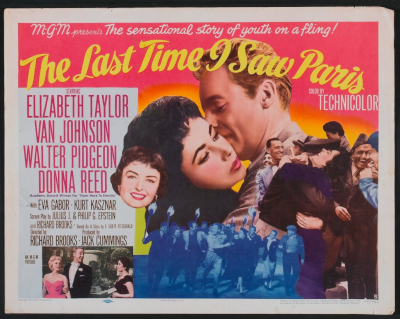
The
Last Time I Saw Paris was based on the F Scott Fitzgerald short story
Babylon Revisited and marked Roger's film debut. He had a contract with
MGM at the time - although they seemed to show little interest in
activating their option on him until this film arrived. He was asked to
report to Culver City Studios in Hollywood where the Irving Thalberg
building dominated the landscape. Roger was 26 years-old and awed by
the studio with its collection of lots - all with spectacular backdrops
to use in films. New York City streets, railway tracks, cowboy towns,
lakes, rivers. The stars of the film were Elizabeth Taylor and Van
Johnson with Roger some way down the cast list as a minor supporting
player. The talented director Richard Brooks would further enhance his
reputation with films like Blackboard Jungle, Cat on a Hot Tin Roof,
and Elmer Gantry.Fitzgerald's
writing heralded the birth of what the author himself would term The
Jazz Age. Beautiful young people who are self-absorbed, live a life
full of excess and are determined not to be ignored by anyone - however
notorious they become or how much offstage gossip and innuendo they
attract. These lives might be enviable to the casual observer but at
heart, under the full glare of the bright lights, there was something
melancholic about the age. No amount of alcohol and bons mots could
completely wipe away the essentially frivolous and superficial
experience that was an unavoidable part of being part of the "it"
crowd. The ennui and sense that there was something more to life. The
Last Time I Saw Paris relocates the story to the World War 2 era but
the core themes still remain.The
Last Time I Saw Paris concerns writer Charles Wills (Van Johnson)
remembering his life in Paris after the end of the Second World War
where he met the beautiful Helen (Elizabeth Taylor). The relationship
between the two plays out with some soap operish elements (drinking,
arguments etc) and many of Fitzgerald's preoccupations and concerns.
Wealth, class, old money versus new money, boredom, happiness, alcohol.
More than anything the film is like a coming out party for Elizabeth
Taylor. Now in her early twenties, the former child star has graduated
to adult roles and is a bona fide star in the Hollywood firmament.
Helen comes from a modest background but uses her beauty to pursue a
better lifestyle. However, when wealth comes her way she becomes more
responsible. There is a lot going on in the story around the theme of
snobbery. How people view one another through the prism of bank
balances and where they were educated.Those
with inherited wealth (old money) have a social standing that is much
more secure amongst the vacuous society types they mingle with. For
those with new money though it's another story. These people are more
vulnerable and even slightly looked down upon for their nouveau riche
status - as if they are transient interlopers trying to gatecrash the
natural order of things. The characters are often anhedonic as they
seek some sort of fulfillment which may not even be possible. Perhaps
the decision to change the setting of the novel from the start of the
1930s to post-World War 2 means something is slightly lost in
translation. Fitzgerald belonged to the Roaring Twenties, the Jazz Age.
A time of great prosperity for America. Wild parties, prohibition,
bootleggers, new money, people becoming rich. It isn't destined to
last. The great stock market crash of 1929 is just around the corner
and will serve as the sobering hangover and symbolic end for this
glitter strewn decade of excess. The reality crash. It would maybe make
more sense for these characters to be searching for lost dreams after
that era.Van Johnson is a solid
lead as the man who ends up on a very personal and emotional mission
and Walter Pidgeon is the stalwart father of Elizabeth Taylor and Donna
Reed as her sister. What of Roger? Roger - looking incredibly young -
flits into the film as a tennis playing gigolo who has a fling with
Helen and makes Van Johnson jealous. Roger doesn't have an awful lot to
do in the film but you can see why his good looks encouraged studios to
have him on a contract just in case they needed a dashing young actor
for any particular part. The Last Time I Saw Paris is certainly one for
Elizabeth Taylor fans and - while not a great film - it is an
entertaining one with some lovely authentic location work in Europe.
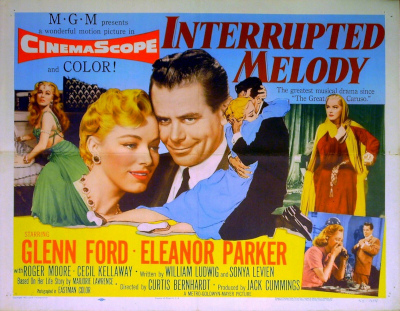
Roger's
second film was a supporting role in 1955's Interrupted Melody - a
biopic of Australian opera singer Marjorie Lawrence. Lawrence valiantly
battled polio after huge success in the 1930s and the film is an
adaptation of her book about her ups and downs and experiences around
the world as a famed singer. Lana Turner, Greer Garson, and Kathryn
Grayson were considered to play Lawrence but it was Eleanor Parker who
won the role. Glenn Ford was cast as Marjorie's doctor husband Thomas
King while Roger plays her brother Cyril. The voice of Lawrence singing
was supplied by Eileen Farrell. Interrupted Melody is regarded to be a
fine biopic of the era and arguably the highlight of Eleanor Parker's
career. Interrupted Melody has a fascinating figure to explore and does
the subject a decent amount of justice with this well mounted and well
acted film. The songs are very pleasant and affecting and there is some
top notch acting by Parker and Ford in the lead roles. MGM failed to
lobby for Parker to get an Oscar nomination and one can see why some
lamented this after the film had come and gone. The actress has some
memorable moments in the film. Dragging herself across the floor to
shut down a record player running one of her old recordings, singing
Waltzing Matilda to compatriots, crooning Over the Rainbow from her
wheelchair.The film looks grand
in CinemaScope and Technicolor with fine art decor and Eileen Farrell
is superb as the voice of Marjorie Lawrence during the songs. The opera
sequences are well staged too and give one a sense of what a dramatic
and spectacular star the singer must have been at her finest. Glenn
Ford is excellent as her devoted husband and lends some extra gravitas
and drama to the story. In his memoir, Roger recalled that Ford would
deliberately nix takes until he got one that was to his liking and had
all manner of tricks to make sure he his profile dominated the screen
in two person scenes! The story takes us from the early days of talent
competitions to fame in Paris to the battle with polio and the
recovery, World War 2 etc. It's an inspiring story for a biopic the
filmmakers deserve a lot of credit for the way they make the operatic
scenes - which include scenes from La Boheme, Il Trovatore, Madama
Butterfly - feel real and complete, aided immeasurably by Parker
capturing the style and movement of Lawrence.The
actress is never less than completely committed and excellent in
presenting the despair, depression, and triumphant return of Lawrence
as she battles both her illness and her emotions. Interrupted Melody is
maybe a trifle schmaltzy to modern tastes at times but this is a
sentimental old-fashioned biopic based on a true story. You'd have to
have a heart of stone to be too critical. Parker never really seems to
attempt an Australian accent and a young Roger, as her guilt stricken
brother Cyril, doesn't go too far in this direction either. I suppose
Hollywood films (especially back then) were made primarily for domestic
consumption and studio executives were not terribly bothered by how
authentic foreign accents were because audiences probably didn't really
care. This is very much a vehicle for Parker and, to a somewhat lesser
extent, Ford. Roger is one of the few other actors to play any part in
the story. He's decent enough in his scenes. On the whole, Interrupted
Melody is an enjoyable and handsome musical romantic drama and perfect
viewing for a rainy afternoon.
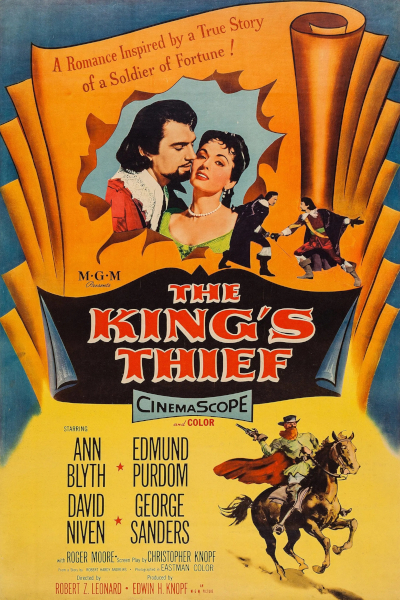
The
King's Thief is a 1955 Hollywood swashbuckler with many British actors
in the cast. The film was roasted by critics and isn't fondly
remembered (even Roger jokes about how awful the film was in his
autobiography) but the picture was important to Roger on a personal
note because he became great friends with David Niven through it. The
production was notable for some behind the scenes intrigue with Edmond
Purdom frequently holding everyone up with constant telephone calls due
to his affair with Linda Christian. Another British cast member, George
Sanders, was prone to snoozing in his dressing room. It's a wonder the
film was ever finished! What is the plot of this film you ask? In the
time of King Charles II (George Sanders), the dodgy Duke of Brampton
(David Niven) uses the King's misplaced trust to have wealthy subjects
executed so he can acquire their money and possessions. When this
secret falls into the hands of bandit Michael Dermott (Edward Purdom),
he teams up with Lady Mary (Ann Blyth) and his comrade Jack (Roger) to
see that some sort of justice is done...The
King's Thief is a forgotten swashbuckler from the fifties that wastes
an interesting cast with a fairly ho-hum adventure and a predictable
and somewhat bland screenplay. It's certainly interesting though to see
the usually warm onscreen persona of Niven as a villain and he's decent
value as an absolute bounder and scoundrel. There is much swordplay and
mayhem and some enjoyably old-fashioned painted backdrops but the film
never really comes together and lacks a certain sense of panache. It's
no Adventures of Robin Hood. Ann Blyth is well cast as the orphaned
Lady Ann, encouraged to investigate the Duke herself after the death of
her father. Edmond Purdom, a British actor who was once tipped for
stardom but ended up in relative obscurity, is not bad as the soldier
of fortune who adjusts his moral compass to go from bandit to hero.The
darkly handsome Purdom looks like he might have made a decent James
Bond in the 1960s although - ironically - basing himself in Hollywood
and then Italy (as his career began to stall) probably stopped him from
ever having that chance meeting with Albert Broccoli or Harry Saltzman.
George Sanders is costumed to the nines as the King and Roger plays an
accomplice of Purdom who joins in with the quest to expose Niven's
baddie. Roger doesn't actually have an awful amount to do in the film
(and only has fifth billing amongst the cast) but he makes a pretty
dashing period swashbuckler and what he is given to do he does well.
The highlight of the film is probably the prison break sequence with
Purdom and Roger. There are a few bright spots along the way and it's
always interesting to see this cast together but The King's Thief is a
forgettable adventure film that hasn't stood the test of time terribly
well.
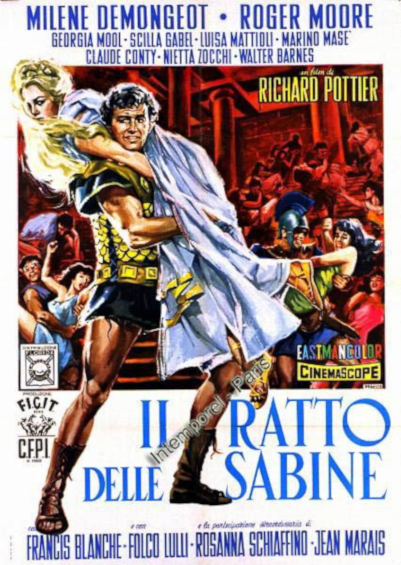
Romulus
and the Sabines (Il ratto delle sabine) is a 1961 Italian/French swords
and sandals picture directed by Richard Pottier. A film inspired by the
mythological Rape of the Sabine Women. Roger was persuaded to
participate by his agent at the time - despite the fee on offer seeming
rather modest. Appearing in European films was seen as a way to boost
one's profile and stay busy. It certainly worked for Clint Eastwood.
Romulus and the Sabines was not a huge success though and has largely
been forgotten today. It was a cheapjack production with not much money
to go around. Roger was supposed to make another Italian picture after
this but he had so much trouble getting his money for Romulus and the
Sabines he decided not to bother. In his memoir, Roger reflects that it
was an interesting experience making the film, especially as the actors
spoke lines in their native languages on the set.In
Romulus and the Sabines, Roger plays Romulus - the founder of Rome.
Romulus needs to aquire some women for his men and so orders that some
be taken from Sabina. The folks in Sabina are not delighted at having
their women stolen though and stage an attack on Rome to rescue them.
Cue plenty of historical shenanigans and much fighting. This is the
sort of film you'll find playing in the afternoon on some obscure film
channel and end up watching. It's entertaining enough at times but
don't expect Spartacus or Ben-Hur. Despite the 'rape' part of the
original title the film is fairly inoffensive to modern eyes now and
the scenes where the women are kidnapped and taken away seem more
comical than emotional. The women don't seem that bothered about taken
away and in some cases happy enough in the end! It's a bawdy comedy as
much as anything.It's fun to see
a very boyish looking Roger in the years before he found fame as
English gentlemen adventurer types. Rog has a mop of curly hair here
which makes him look slightly like the former tennis player Andy
Murray. It seems that at this stage of his career no one was completely
sure of what to do with Roger and this is someone giving him a whirl at
being the butch historical figure. The role of Romulus in a
lowish-budget sword wielding caper of this era would usually have gone
to a muscleman like Steve Reeves so it's interesting to see Roger Moore
- who looks skinny and plausible of body in the film - tackle this type
of part. He's not completely in his element but his film star looks
make him a stylish looking lead. Roger even gives Romulus an eyebrow
raising moment or two.The acting
is variable amongst the supporting cast and other leads but Mylène
Demongeot fares best as Réa, the daughter of Titus. Demongeot had
recently caught the eye in Otto Preminger's lavish CinemaScope
Technicolor dappled sun glazed seas of the French Riviera set Bonjour
Tristesse based on the novel by Françoise Sagan where she played the
young mistress of David Niven's character. Demongeot, who was actually
billed above Roger in the film, makes for a good heroine here and
sprinkles some class into the film that it may not completely deserve.
Romulus and the Sabines is no classic but it does what it says on the
tin. Fights, romance, banquets, hokey costumes. It's Sunday afternoon
fluff and as far Sunday afternoon fluff goes not completely disposable.
In many ways the film marks the end of the first phase of Roger's
career as a baby-faced young actor trying to grope his way to fame and
an established persona. The next time he made a feature film he would
be best known as Simon Templar and only a few years away from a certain
secret agent by the name of James Bond.- Jake
© 2025
Alternative 007
|

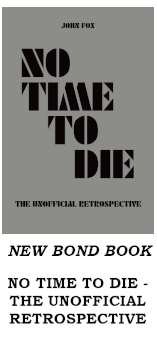

|






